
Monza is a city and comune on the River Lambro, a tributary of the Po in the Lombardy region of Italy, about 15 kilometres north-northeast of Milan. It is the capital of the Province of Monza and Brianza. Monza is best known for its Grand Prix motor racing circuit, the Autodromo Nazionale di Monza, which hosts the Formula One Italian Grand Prix with a massive Italian support tifosi for the Ferrari team.

Nearco was an Italian-bred Thoroughbred racehorse described by Thoroughbred Heritage as "one of the greatest racehorses of the Twentieth Century" and "one of the most important sires of the century." He was unbeaten, winning 14 races at distances from 1000m to 3000m, including the Derby Italiano and Grand Prix de Paris. He was then sold for a record amount to Martin H. Benson and stood stud in England, where he became the patriarch of several of the most dominant sire lines in Thoroughbred history.

The Guelphs and Ghibellines were factions supporting the Pope and the Holy Roman Emperor, respectively, in the Italian city-states of Central Italy and Northern Italy.

The Visconti of Milan are a noble Italian family. They rose to power in Milan during the Middle Ages where they ruled from 1277 to 1447, initially as lords then as dukes, and several collateral branches still exist. The effective founder of the Visconti lordship of Milan was the archbishop Ottone, who wrested control of the city from the rival Della Torre family in 1277.
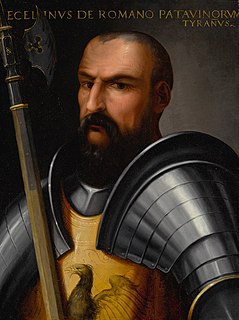
Ezzelino III da Romano was an Italian feudal lord, a member of the Ezzelino family, in the March of Treviso. He was a close ally of the emperor Frederick II, and ruled Verona, Vicenza and Padua for almost two decades. He became infamous as a cruel tyrant, and was, in fact, the most "notorious" of the "early tyrants".

Pisanello, born Antonio di Puccio Pisano or Antonio di Puccio da Cereto, also erroneously called Vittore Pisano by Giorgio Vasari, was one of the most distinguished painters of the early Italian Renaissance and Quattrocento. He was acclaimed by poets such as Guarino da Verona and praised by humanists of his time, who compared him to such illustrious names as Cimabue, Phidias and Praxiteles.
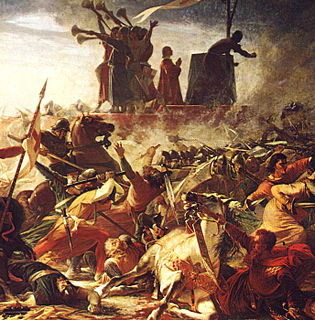
The Battle of Legnano was a battle between the imperial army of Frederick Barbarossa and the troops of the Lombard League on May 29, 1176, near the town of Legnano in present-day Lombardy, in Italy. Although the presence of the enemy nearby was already known to both sides, they suddenly met without having time to plan any strategy.

The Archdiocese of Milan is a Latin Church ecclesiastical territory or archdiocese of the Catholic Church in Italy which covers the areas of Milan, Monza, Lecco and Varese. It has long maintained its own Latin liturgical rite usage, the Ambrosian rite, which is still used in the greater part of the diocesan territory. Among its past archbishops, the better known are Saint Ambrose, Saint Charles Borromeo, Pope Pius XI and Saint Pope Paul VI.

The Duchy of Mantua was a duchy in Lombardy, Northern Italy. Its first duke was Federico II Gonzaga, member of the House of Gonzaga that ruled Mantua since 1328. The following year, the Duchy also acquired the March of Montferrat, thanks to the marriage between Gonzaga and Margaret Paleologa, Marchioness of Montferrat.

A Carroccio was a large four-wheeled wagon bearing the city signs around which the militia of the medieval communes gathered and fought. It was particularly common among the Lombard, Tuscan and, more generally, northern Italian municipalities. Later its use spread even outside Italy. It was the symbol of municipal autonomy. Priests celebrated Mass at the altar before the battle, and the trumpeters beside them encouraged the fighters to the fray.

Giovanni Santi was an Italian painter, decorator, and the father of Raphael. He was born in 1435 at Colbordolo in the Duchy of Urbino. He studied under Piero della Francesca and was influenced by Fiorenzo di Lorenzo. He was court painter to the Duke of Urbino and painted several altarpieces. He died in Urbino.
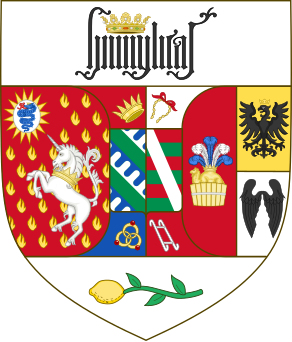
The aristocratic Borromeo family were merchants in San Miniato around 1300 and became bankers in Milan after 1370. Vitaliano de' Vitaliani, who acquired the name of Borromeo from his uncle Giovanni, became the count of Arona in 1445. His descendants played important roles in the politics of the Duchy of Milan and as cardinals in the Catholic Reformation. In 1916 the head of the family was granted the title Prince of Angera by the King of Italy.

Federico Tesio was an Italian breeder of Thoroughbreds for horse racing. He has been called "the only genius ever to operate in the breeding world" and "the greatest single figure in the history of Italian racing".
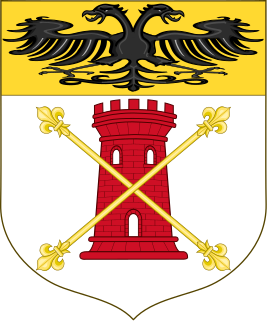
The Della Torre were an Italian noble family who rose to prominence in Lombardy during the 12th–14th centuries, until they held the lordship of Milan before being ousted by the Visconti.

Castritian was Bishop of Milan in mid 3rd-century. He is honoured as a Saint in the Catholic Church and his feast day is on December 1.

The Company of Death is the name used in the historical literature of English language for two related chosen tactical corps, two selected bands of warriors, entrusted to guarantee the cohesiveness and efficiency in battle of both the Milanese and Lombard League's militias through their bond by oath to the defence of the Milanese Carroccio, the wagon on which the standard of the Lombard allies stood.

The Oratorio di San Protaso is a church in via Lorenteggio, Milan, Lombardy.
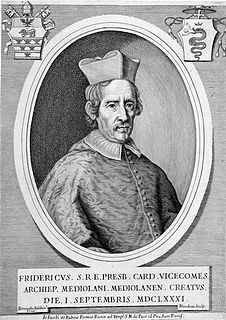
Federico Visconti (1617–1693) was an Italian Cardinal and Archbishop of Milan from 1681 to 1693.

The oath of Pontida, according to tradition, would have been a ceremony that would have sanctioned on 7 April 1167, in the abbey of Pontida, near Bergamo, in Italy, the birth of the Lombard League, or of a military alliance between the municipalities of Milan, Lodi, Ferrara, Piacenza and Parma aimed at the armed struggle against the Holy Roman Empire by Frederick Barbarossa.

The Visconti Castle or Castello Visconteo is a castle in the town of Cusago near Milan, Lombardy, Northern Italy. It was built in the 14th century by Bernabò Visconti and used as a hunting lodge by him and other members of his family. The castle underwent significant changes in the Renaissance period. Today it is in a state of neglect.



















